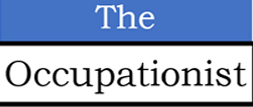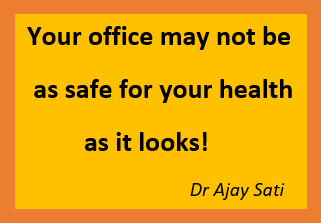Companies and some Occupational Health (OH) physicians often get overwhelmed when it comes to establishing OH in the factory and/or office. In India, companies usually comply by establishing OH in their factories as per recommendations of Indian Factories Act. However, there are companies who go far beyond the local laws.
Occupational Health is a medical specialty that is preventive. There are methods by which OH prevents hazards at workplace from harming employee health. OH identifies hazards and takes steps to mitigate them to as low as reasonably practicable so that employee health is preserved.
Most companies lack an awareness and hence do not even consider that hazards could be present in their well-appointed, safe-looking corporate office. Look of an office may be pleasant to the eyes, it may not be pleasant to people occupying it. An employee working in the office can be exposed to a lot of hazards that could harm health, depending on the job being done.
Usually office housekeeping is managed by the Admin team and they do a wonderful job in keeping the office clean. Inputs sought by the Admin team from a OH physician will bring synergy to the clean office and make the office safe too for employee health. A small office, or a large corporate office having thousands of employees may not be keen to establish OH as they are out of Indian Factories Act. Absence of OH in offices can harm employee health – we will see it in the paragraphs below.
A clean looking office should not be mistaken for a safe office. In fact, no workplace (office or factory) is safe for human health; it has to be made as safe as reasonably practicable.
How to make an office safe?
Ideally, an Occupational Health Risk Assessment (OHRA), however basic, should be undertaken to identify all hazards in the office and steps taken to mitigate them. Even if OH is established in bits and pieces, it will help, rather than not taking any action about the potential hazards in the office.
By bits and pieces Occupational Health is meant that even if an office is unable to establish OH to a certain level due to lack of expertise or financials, taking up any of the hazards identified or doing a little bit randomly will at least take care of a hazard potentially harmful to health. Over a period of time, various hazards could be picked up for its mitigation.
Let us see a few of the many examples of hazards that are found in an office which can be unsafe for the health of the workers.
1.Working with computers: In offices, most of the employees work with computers. It is the time spent continuously with computers that causes harm to health in the form of headache, eye strain, wrist pain, numbness in fingers, neck pain, back pain etc.
There are a few ways by which employees can escape these health issues, the basic being taking frequent breaks. I suggest a break for 2 minutes after every 30 minutes and this is what one has to do – stretch yourself while in the chair, rotate your eyeballs clockwise and anti-clockwise, get up from the chair, walk a few steps, go near a window and see a distant object and return back to the chair. How many of us do that.
Another approach is to do a workstation ergonomic assessment, which also can be done using a software. I have the experience of using Remedy and I found it immensely useful. After the assessment using Remedy, it prompts to instal a software in the computer that tracks how much time you have spent with the computer and other details. It prompts you when to take a break, its various options and for how long.
Last but not the least, make sure you drink enough water to manage fatigue at work.
2.Food and water safety: If food is provided by the employer, it becomes a moral responsibility to provide safe and healthy food. In case of food poisoning, food supplied by the employer and consumed in its work locations is considered an Occupational (work-related) illness.
If food is not provided by the employer, there must be arrangements to keep the food safe that brought by employees from home. A refrigerator, a microwave oven be provided by the employer for use by employees as necessary. Food consumed must also be at the right temperature.
Unsafe food leads to food poisoning that impacts many employees at the same time and hence it is necessary to be mindful of it and not lose day(s) due to ignoring a simple consideration.
3.Provision of first-aid: It is good to offer first-aid training to employees, have a tie-up with an ambulance provider and access to multi-specialty hospitals nearby, if possible to be able to mange any illness or accident that might occur in the office premises.
4.Air-conditioning and air-quality: The temperatures in the offices must be properly maintained. We talk about air pollution but what about air-quality in the office areas? It is advisable to check the HVAC (Heating, Ventilation and Air Conditioning) control system and air quality once in 6 months or as necessary.
5.Storage: Pesticides, if at all should be stored separately, away from where food is stored.
6.Changing room: Food-handlers and janitors must have designated changing rooms.
7.Training: Food-handlers and janitors should undergo regular training regarding personal hygiene. Supervisor managing food-handlers and janitors must follow a daily check-list and act accordingly.
8.Unseen hazards: Discrimination, toxic culture, overwork, etc. are some of the unseen hazards at workplace that if not addressed aptly can lead to resentment, absence from work, attrition, low performances and eventually illness. Wellness programs which are part of OH setup must account for these unseen hazards and any more and address them effectively by having policies, yet subtly.
9.Etc.
In addition, there is Sick Building Syndrome (SBS) and Building Related Illness (BRI), about which I will blog separately in future.
If the office does not have a doctor (either part-time or full-time), a Walkthrough Workplace Assessment (WWA) of workplace helps. WWA is done by a randomly picked team of office employees from various departments led by a member of a senior management or even a CEO, who walk around the office and look for safety and/or health hazards. WWA is useful even if you have a doctor or an OH physician as new hazards may crop up anytime.
In a workplace where there is a doctor (either OH physician or a doctor with interest in Occupational Health), the admin and the HR with the support of senior management can work together in sync with the doctor and seek health related inputs to provide a clean looking yet ‘safe for health’ workplace.
Even if Occupational Health is established in bits and pieces, it will help, rather than not taking any action about the potential hazards in the office.
The same applies to employees who work from home. In fact, employees those who work from home are in danger of deteriorating their health faster than office going employees – both physical health as well as mental health.
So, if you thought that office is a safe place and cannot harm your health, think again! Ditto for your home, if you are ‘working from home’ – one more reason for you to select ‘hybrid mode of working’ rather than any one.
Establishing OH practices and involving the employees in workplace often brings rewards in terms of employee satisfaction; and is one of the ingredients in improving workplace productivity. This is also the time for all stakeholders to act and make the workplace compliment your health and not rob away your energies by the end of the day or even earlier.
For more info, contact
____________________________________________________________________________________
Dr Ajay Sati is an Occupational Health physician who prefers to describe himself as an Occupationist, to denote, ‘an expert in diseases and other concerns of occupations.’ Dr Sati has managed health and wellness programs in industries he worked, like the atomic energy, and energy (oil & gas) in India and overseas. An experienced virtual consultation expert he was involved in many greenfield and brownfield projects providing inputs from health point of view.



